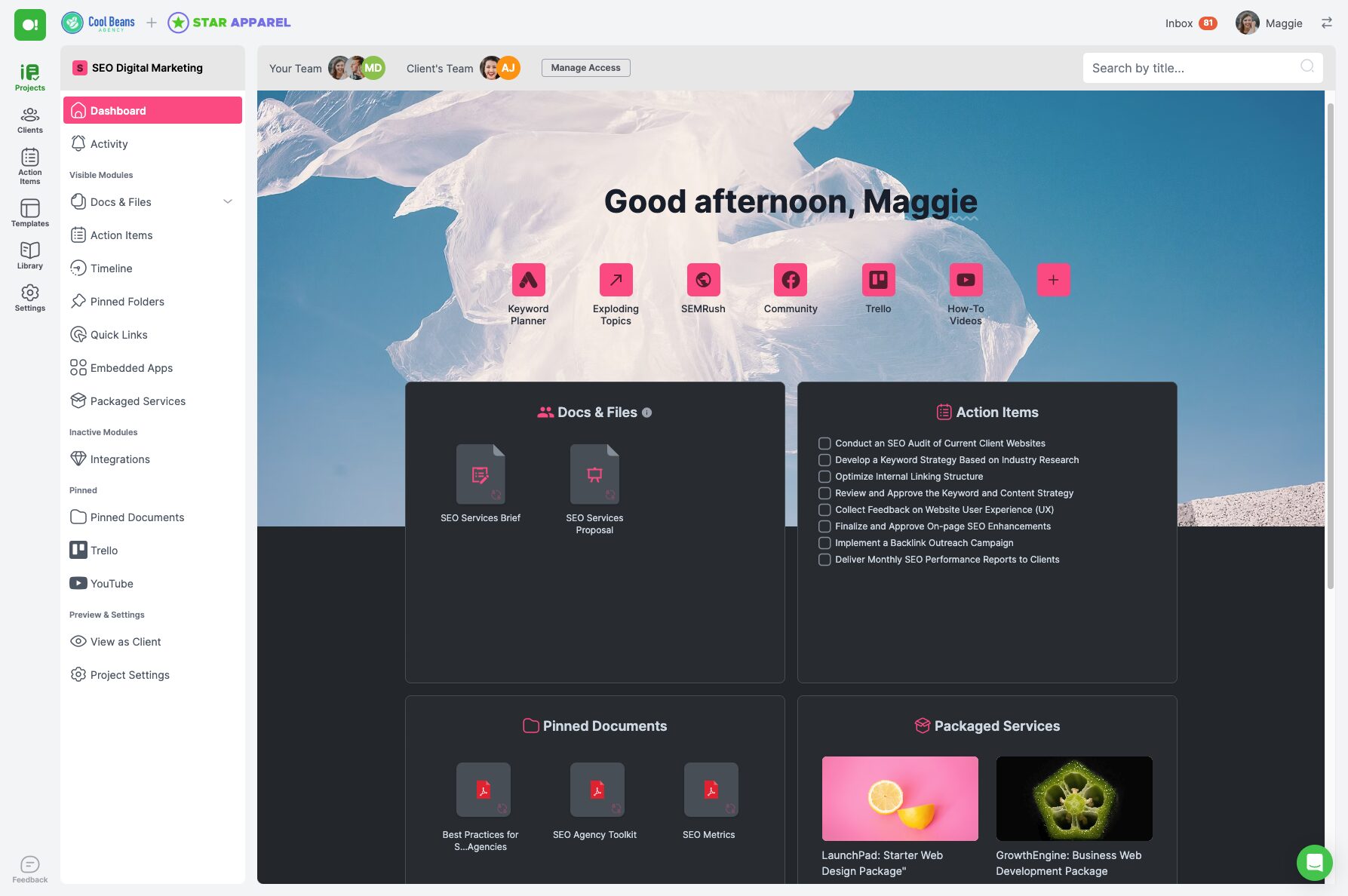
The freelance space comes with its own set of unique challenges, including finding consistent work and managing multiple projects. However, learning how to look Professional as a Freelancer to potential clients might help you become more successful. A polished image can be the edge you need to attract a new client over a competitor.
In this article, we explore ten essential tips to help you look more professional as a freelancer. From adopting advanced tools like SuperOkay for better client interactions to refining how you communicate and manage your online presence, every detail counts. These strategies aim to build trust and credibility, and to reassure your clients that choosing you is the right decision.
Ready to step up your freelance game? Let’s get into the practical steps:
1. Adopt a Client Portal
A great way to start knowing how to look Professional as a Freelancer is to use a client portal like SuperOkay. The platform acts as a central hub where clients can access all project-related docs and files. It creates transparency by allowing clients to review documents, and communicate with you in multiple ways. The use of a client portal signals to clients that their work is in good hands, organized, and accessible.
SuperOkay stands out because of its user-friendly interface and robust functionality. It simplifies project management by integrating task management tools (action items), file sharing, and document approvals all in one app. Clients appreciate the ability to have a single point of contact that keeps them updated without the need to juggle between google drive and email. This can make the difference in winning a client and also in maintaining a long-term working relationship.
Clients often look for freelancers who are not only skilled in their craft but also in the management of their business. When you simplify the project management side of your business, you free up more time to focus on the actual work, thus improving overall productivity and client satisfaction.

2. Make a professional website
Your website often serves as the first point of contact between you and potential clients. It’s crucial to make sure this first impression is both professional and inviting when learning how to look professional as a freelancer. A well-designed website should clearly communicate who you are, what you offer, and how potential clients can contact you. It should feature a clean, easy-to-navigate layout, professional graphics, and high-quality content. Including a portfolio of your work along with client testimonials can also enhance your credibility and showcase your skills.
Moreover, a professional website should be optimized for search engines to help you reach a broader audience. Implementing SEO best practices can lead to higher rankings in search results, increasing your visibility and the likelihood of attracting new clients. Regular updates with fresh content can also keep your site dynamic and engaging for repeat visitors. This might include a blog where you share industry insights, tips, or recent projects, which helps establish your authority in your field.
Finally, consider the technical aspects of your website, like its loading speed and mobile responsiveness. With a growing number of people accessing websites via mobile devices, your site must perform well across all platforms. A fast, responsive website enhances the user experience and contributes to a professional image, assuring clients of your attention to detail and your focus on quality.
3. Use professional communication tools
Professional communication is very important in how to look Professional as a Freelancer. Opting for a custom domain name for your email address, rather than using generic services, can help quite a bit. This small investment shows a level of professionalism that clients appreciate, and distinguishes your business from less serious competitors. Tools like Slack or Teams for instant messaging and Zoom for video conferencing can also improve your image by showing your adaptability to modern and efficient communication.
Maintaining a high standard of communication ensures you keep projects smooth and clients feel informed and valued. Consistency, timely responses, and clear messaging are key to build and maintain trust. Also, using project management tools (like SuperOkay) can help keep all communications organized by project, which is especially helpful when you need to track conversations or get information quickly.
You can also think about integrating SuperOkay into your routine to simplify your processes. When learning how to look professional as a freelancer, automating communications, such as project updates, can free up time for more critical tasks, making sure nothing falls through the cracks.
4. Regularly update your portfolio
A diverse and current portfolio is crucial in demonstrating your skills and the scope of your experience to potential clients. Make sure to include a variety of projects that showcase different aspects of your expertise. This not only highlights your versatility but also shows your growth and adaptability. Each project in your portfolio should include a brief description, the objectives, and the outcomes, which helps potential clients visualize how you can solve their specific problems.
As you complete new projects, adding them to your portfolio keeps it fresh and relevant. This practice also provides an opportunity to reflect on your work, understand what has been successful, and identify areas for improvement. Regular updates communicate to clients that you are active in your industry, which can lead to more business opportunities.

In addition to showcasing completed projects, your portfolio can also include testimonials from satisfied clients. Feedback is a powerful tool that adds credibility to your image as a professional. Make sure these testimonials are visible and reflect the breadth of your client base. This not only boosts your reputation but also reassures potential clients about the quality of your work and your commitment to client satisfaction.
5. Maintain a professional workspace
Whether you meet with clients in person or through digital platforms, having a professional workspace is essential. A tidy and organized office or desk helps your productivity and sends a strong message to clients about your work ethic and organizational skills. If you do video calls, ensure that the visible area is clean, well-lit, and free from distractions. This environment reflects your professionalism and helps to maintain the focus on your conversation.
For freelancers who invite clients to their physical workspace, it’s important to create a welcoming and professional atmosphere. This includes having a comfortable seating area for discussions and making sure that your workspace is indicative of your work. For instance, creatives might display their artwork or awards, while those in technical fields might showcase their tools and equipment neatly.
Maintaining a dedicated workspace can help in separating personal and professional life, which is a common challenge for freelancers. By delineating a specific area for work, you signal to yourself and clients that you are in a professional mode, fully focused on them. This physical distinction can help manage work-life balance and reduce stress, contributing to a more professional service.
6. Be on time and respect deadlines
Punctuality reflects your respect for your client’s time and illustrates your organizational skills. By consistently meeting or arriving early for appointments and deadlines, you demonstrate reliability, a trait highly valued in any professional setting. This consistent behavior helps build trust and reassures your clients that they can depend on you to manage aspects of their projects that require timely attention.
Meeting deadlines is equally important. It signals to your clients that you manage your work effectively and respect the timelines set for the project. To make sure you always meet deadlines, you can consider implement a project management tool, like SuperOkay for example. Break down large tasks into manageable activities, set milestones, and monitor your progress regularly. This systematic approach not only helps in meeting deadlines but also in managing client expectations and adjusting work as necessary.
Communicating proactively about your progress can make a significant difference in how clients perceive your professionalism. If a delay is unavoidable, informing your client ahead of time and providing a new timeline, along with reasons and remediation steps, is a great way to maintain transparency and honesty. Openness in communication not only avoids frustrating situations but also strengthens the professional bond between you and your clients.
7. Continue your education
Staying updated with the latest trends and tools in your field shows clients that you are committed to your profession and capable of delivering cutting-edge solutions. Regularly participating in industry-specific courses, workshops, or webinars not only enhances your skill set but also broadens your understanding of new methodologies that could benefit your clients. This commitment to learning can significantly differentiate you from competitors who don’t invest in their professional growth.

In addition to formal education, informal learning avenues such as following industry leaders on social media, subscribing to relevant journals, and participating in community forums can provide you with valuable insights and keep you ahead of industry developments. This type of ongoing education ensures you remain a knowledgeable and competitive service provider, ready to meet the evolving needs of your clients.
Sharing your learning experiences and certifications with your clients can enhance your credibility. When clients see that you are actively enhancing your skills, they are more likely to view you as a dedicated professional who is invested in delivering the best possible outcomes. This can lead to higher client retention rates and more referrals, which are vital for sustaining and growing your freelance business.
8. Ask for Feedback
Soliciting feedback from clients after completing a project is crucial for any professional who wants to improve. This demonstrates your commitment to quality and customer satisfaction. By asking for feedback, you show you value your clients’ opinions and are open to constructive criticism, which can help future collaborations and refines your approach.
Creating a structured feedback system can make it easy for clients to share their thoughts. Whether you use follow-up emails, surveys, or direct conversations, providing a straightforward and effective method for clients to express their views can yield insights you might not have considered. This feedback is invaluable as it allows you to adjust your practices to better meet the needs of your clients.
Acting on the feedback you receive not only improves your services but also strengthens your relationships with clients. It shows that you listen and respond to their needs, which can significantly enhance their loyalty and trust in your services. Keeping clients updated on how their suggestions have been implemented can also keep them engaged and open to a long-term professional relationship.
9. Offer custom solutions
Tailoring your services to meet the specific needs of your clients demonstrates a high level of professionalism and dedication. By offering custom solutions, you not only address their unique challenges but also enhance the value of your work, making your services more attractive and relevant. This approach allows you to stand out in a competitive market where clients often seek personalized attention and tailor-made strategies.
Understanding the individual needs of each client requires thorough research and communication. Engage with your clients to understand their goals, pain points, and the context in which they operate. This deeper insight helps you devise solutions that are not just effective but also aligned perfectly with their expectations. When clients see that your services are specifically crafted for them, they are more likely to feel valued and satisfied.
Maintaining flexibility in your approach allows you to adapt to changes and feedback throughout the project. This adaptability can be crucial for projects that evolve over time and require adjustments to the original plan. When clients see your ability to modify solutions as needed without compromising on quality or timelines, they trust you more. This trust often leads to repeat business and referrals, which are vital for building a successful freelance career.
10. Maintain a strong social media presence
A strong social media presence extends your professional image beyond your immediate network and can significantly enhance your visibility as a freelancer. Platforms like LinkedIn allow you to share industry-relevant content, engage with other professionals, and showcase your expertise and achievements. Actively participating in these networks helps you build a professional brand that attracts potential clients and positions you as an authority in your field.
Regularly updating your social media profiles with new projects, insights, and relevant articles keeps your audience engaged and informed about your activities and professional growth. This continuous engagement is crucial to maintain visibility and relevance in the digital world. It also creates a platform for past clients to endorse your skills and for new ones to discover the quality of your work through these testimonials.
Using social media for networking opens up opportunities to connect with other professionals and potential clients. These connections can lead to collaborations, partnerships, and even referrals, all of which can expand your business. Social media networking involves interacting with others people’s content, sharing useful information, and participating in discussions, which can increase your credibility in your industry.
Conclusion
Learning how to look Professional as a Freelancer is about more than just the quality of your work; it involves how you manage relationships and present yourself. Adopting a tool like SuperOkay and following the tips we discussed, will help you create a sustainable and successful career. These strategies not only improve your professional appeal but also increase trust and credibility with your clients.
When clients see you as a dependable, proactive and skilled professional, they are likely to hire your services repeatedly and recommend you to others. This reputation for professionalism can become your most valuable asset, setting you apart in your market.
Lastly, remember that knowing how to look professional as a freelancer is an ongoing journey, not a destination. Continuously refining your skills, updating your practices, and adapting to new technologies will keep you relevant and in demand. By committing to this path of professional development, you ensure a rewarding and dynamic career as a freelancer, equipped to meet the challenges and opportunities that come your way.
Frequently Asked Questions (FAQ)
What is a client portal?
A client portal is a private, secure web app that gives clients access to project information, allows for communication and file sharing, and provides tools for collaboration.
How important is a professional website for a freelancer?
Extremely important—it acts as your digital business card and is often the first point of contact with potential clients.
What is the best way to request client feedback?
Be direct and sincere, and use specific questions that make it easy for clients to provide useful insights.
Should every freelancer use social media professionally?
While not mandatory, a professional social media presence can greatly expand your network and increase your visibility in your field.
Are you already using a Client Portal? SuperOkay gives you 1 client portal free forever to start creating professional-looking Client Portals, custom branded to your clients’ brands – Start today by clicking here!

How to Become a Freelance Web Designer
In today’s digital era, the demand for skilled web designers is skyrocketing. Companies and individuals alike are in constant need of professionals who can creat…

Work Life Balance for Freelancers
As a freelancer, it can be easy to blur the lines between work and personal life. Without a traditional office setting and set work hours, it can be tempting to work a…

Project Management Life Cycle: What You Need to Know
For freelancers and digital agencies, the whirlwind of tasks and deadlines can be daunting. But what if there was a way to bring order to this chaos, streamline your p…

Scaling Your Agency Online: Optimizing Workflows for Growth
So you’re planning to scale your agency. That sounds good on paper, but most agencies never get beyond wishful thinking. In this guide, we’ll share workflows, strategi…